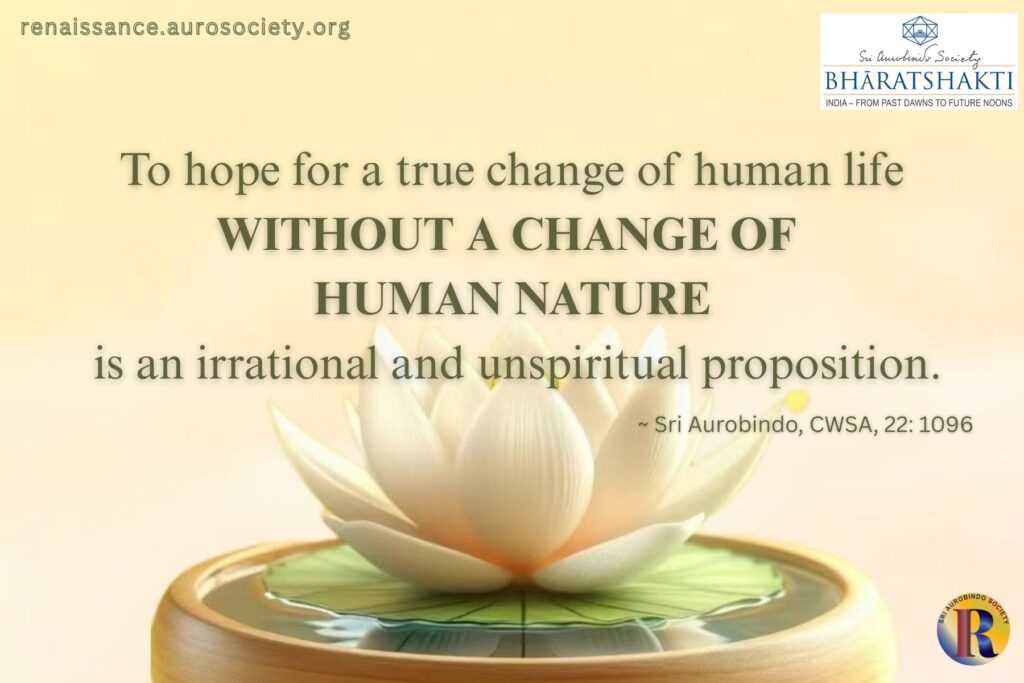Volume V, Issue 1
Author: Sri Aurobindo
Editor’s note: The following is excerpted from Sri Aurobindo’s The Secret of the Veda (CWSA, Vol. 15, pp. 241-247). He summarizes the deeper symbolism behind the legend of Angiras Rishis from the RigVeda, and in the process we learn much about the Vedic symbolism, about who or what is an Aryan, the true meaning of sacrifice, the ignorant reading of Aryan versus Dravidian divide in the Veda, and more.
For the purposes of this digital presentation, we have made minor formatting changes to the original text (with no change in the text), and added a few sub-headings.

The Angirasa legend and the Vritra mythus
As I have already said, the Angiras legend and the Vritra mythus are the two principal parables of the Veda; they occur and recur everywhere; they run through the hymns as two closely connected threads of symbolic imagery, and around them all the rest of the Vedic symbolism is woven. Not that they are its central ideas, but they are two main pillars of this ancient structure. When we determine their sense, we have determined the sense of the whole Rik Sanhita.
If Vritra and the waters symbolise the cloud and the rain and the gushing forth of the seven rivers of the Punjab and if the Angirases are the bringers of the physical dawn, then the Veda is a symbolism of natural phenomena personified in the figure of gods and Rishis and maleficent demons.
If Vritra and Vala are Dravidian gods and the Panis and Vritras human enemies, then the Veda is a poetical and legendary account of the invasion of Dravidian India by Nature-worshipping barbarians.
If on the other hand this is a symbolism of the struggle between spiritual powers of Light and Darkness, Truth and Falsehood, Knowledge and Ignorance, Death and Immortality, then that is the real sense of the whole Veda.
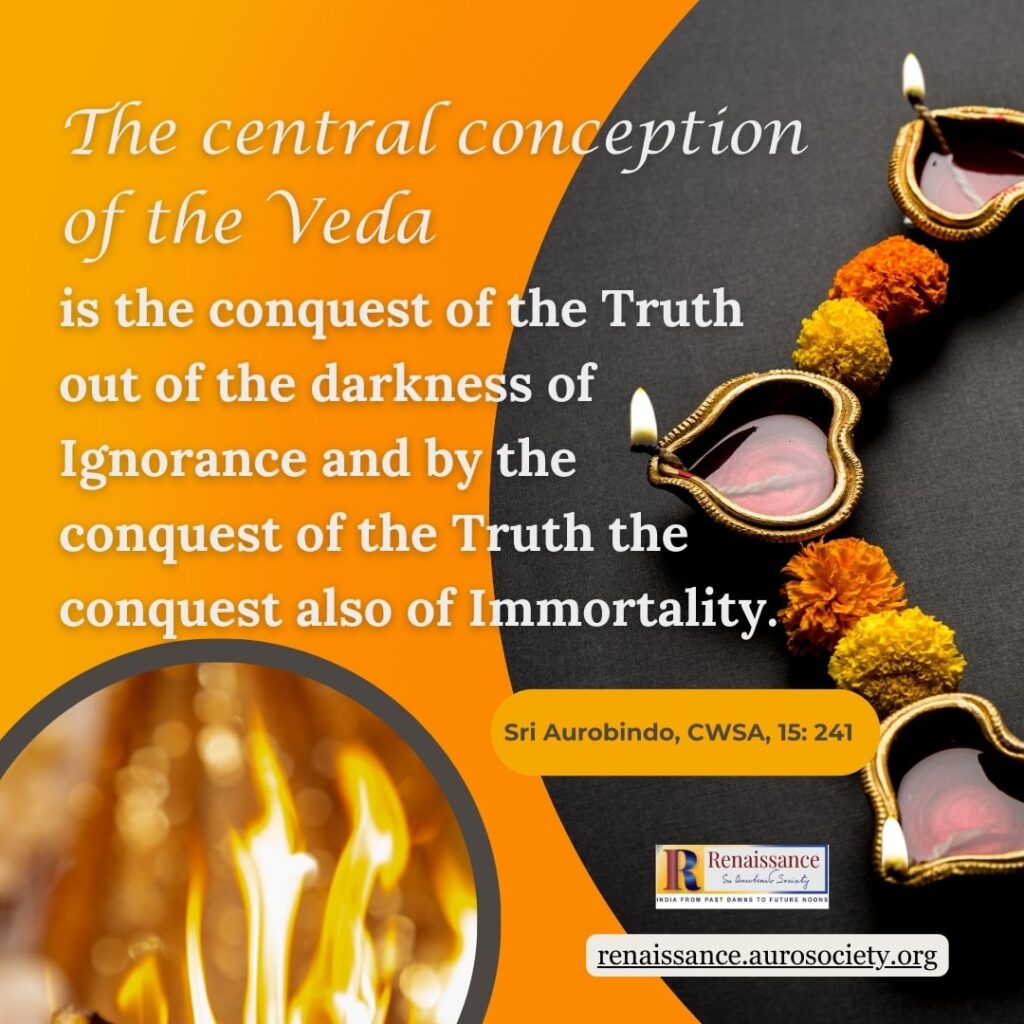
Who are the Angiras Rishis?
We have concluded that the Angiras Rishis are bringers of the Dawn, rescuers of the Sun out of the darkness, but that this Dawn, Sun, Darkness are figures used with a spiritual significance. The central conception of the Veda is the conquest of the Truth out of the darkness of Ignorance and by the conquest of the Truth the conquest also of Immortality.
For the Vedic Ritam is a spiritual as well as a psychological conception. It is the true being, the true consciousness, the true delight of existence beyond this earth of body, this mid-region of vital force, this ordinary sky or heaven of mind. We have to cross beyond all these planes in order to arrive at the higher plane of that superconscient Truth which is the own home of the gods and the foundation of Immortality.
This is the world of Swar, to which the Angirases have found the path for their posterity.
The Angirases are at once the divine seers who assist in the cosmic and human workings of the gods and their earthly representatives, the ancient fathers who first found the wisdom of which the Vedic hymns are a chant and memory and renewal in experience.
The seven divine Angirases are sons or powers of Agni, powers of the Seer-Will, the flame of divine Force instinct with divine knowledge which is kindled for the victory. The Bhrigus have found this Flame secret in the growths of the earthly existence, but the Angirases kindle it on the altar of sacrifice and maintain the sacrifice through the periods of the sacrificial year symbolising the periods of the divine labour by which the Sun of Truth is recovered out of the darkness.
Those who sacrifice for nine months of this year are Navagwas, seers of the nine cows or nine rays, who institute the search for the herds of the Sun and the march of Indra to battle with the Panis. Those who sacrifice for ten months are the Dashagwas, seers of the ten rays who enter with Indra into the cave of the Panis and recover the lost herds.
* * *
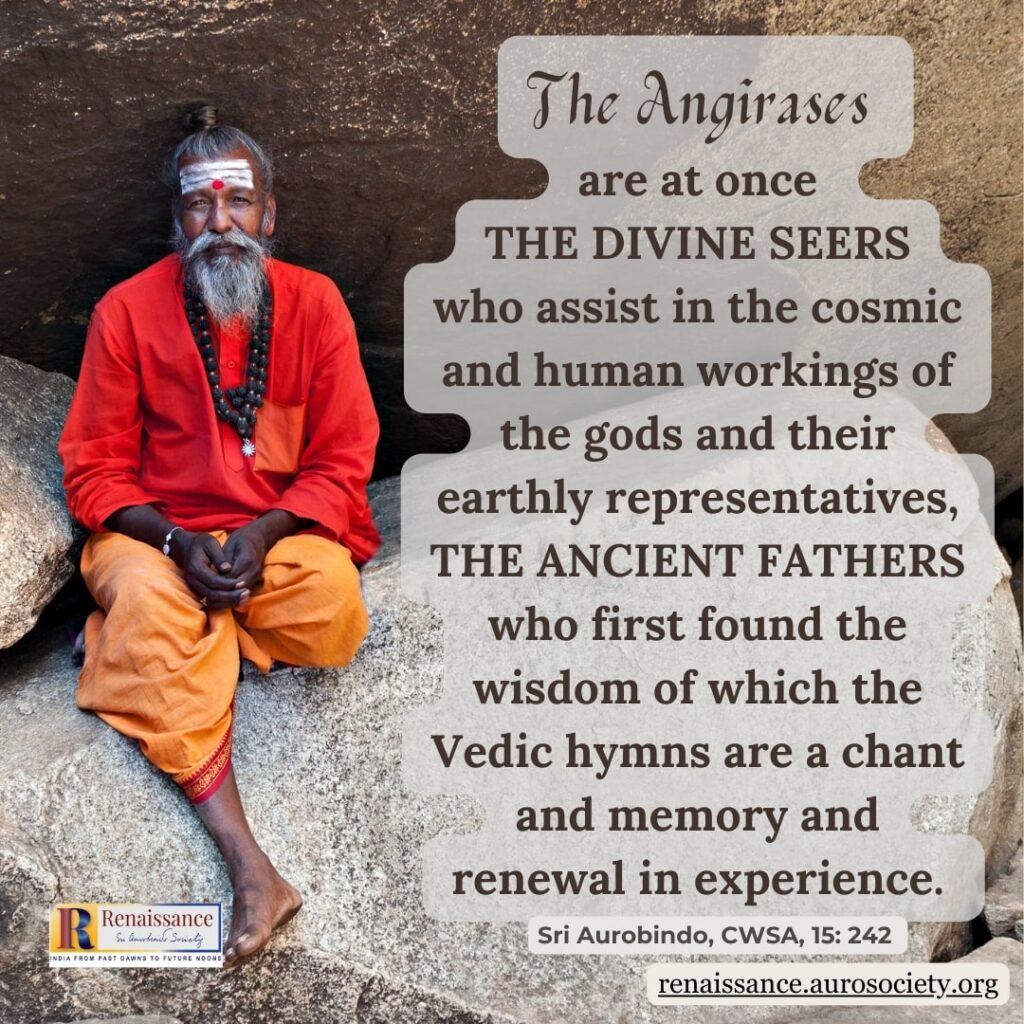
What is meant by the sacrifice?
The sacrifice is the giving by man of what he possesses in his being to the higher or divine nature and its fruit is the farther enrichment of his manhood by the lavish bounty of the gods. The wealth thus gained constitutes a state of spiritual riches, prosperity, felicity which is itself a power for the journey and a force of battle.
For the sacrifice is a journey, a progression; the sacrifice itself travels led by Agni up the divine path to the gods and of this journey the ascent of the Angiras fathers to the divine world of Swar is the type. Their journey of the sacrifice is also a battle, for it is opposed by Panis, Vritras and other powers of evil and falsehood, and of this warfare the conflict of Indra and the Angirases with the Panis is a principal episode.
The principal features of sacrifice are the kindling of the divine flame, the offering of the ghṛta and the Soma wine and the chanting of the sacred word.
By the hymn and the offering the gods are increased; they are said to be born, created or manifested in man and by their increase and greatness here they increase the earth and heaven, that is to say, the physical and mental existence to their utmost capacity and, exceeding these, create in their turn the higher worlds or planes.
The higher existence is the divine, the infinite of which the shining Cow, the infinite Mother, Aditi, is the symbol; the lower is subject to her dark form Diti. The object of the sacrifice is to win the higher or divine being and possess with it and make subject to its law and truth the lower or human existence.
* * *

The ghṛta of the sacrifice is the yield of the shining Cow; it is the clarity or brightness of the solar light in the human mentality. The Soma is the immortal delight of existence secret in the waters and the plant and pressed out for drinking by gods and men. The word is the inspired speech expressing the thought-illumination of the Truth which rises out of the soul, formed in the heart, shaped by the mind. Agni growing by the ghṛta, Indra forceful with the luminous strength and joy of the Soma and increased by the Word, aid the Angirases to recover the herds of the Sun.
Brihaspati is the Master of the creative Word. If Agni is the supreme Angiras, the flame from whom the Angirases are born, Brihaspati is the one Angiras with the seven mouths, the seven rays of the illuminative thought and the seven words which express it, of whom these seers are the powers of utterance. It is the complete thought of the Truth, the seven-headed, which wins the fourth or divine world for man by winning for him the complete spiritual wealth, object of the sacrifice.
Who are the winners of the herds of the Sun?
Therefore Agni, Indra, Brihaspati, Soma are all described as winners of the herds of the Sun and destroyers of the Dasyus who conceal and withhold them from man.
Saraswati, who is the stream of the Word or inspiration of the Truth, is also a Dasyu-slayer and winner of the shining herds; and they are discovered by Sarama, forerunner of Indra, who is a solar or dawn goddess and seems to symbolise the intuitive power of the Truth.
Usha, the Dawn, is at once herself a worker in the great victory and in her full advent its luminous result.
Usha is the divine Dawn, for the Sun that arises by her coming is the Sun of the superconscient Truth; the day he brings is the day of the true life in the true knowledge, the night he dispels is the night of the ignorance which yet conceals the dawn in its bosom. Usha herself is the Truth, sūnṛtā, and the mother of Truths. These truths of the divine Dawn are called her cows, her shining herds; while the forces of the Truth that accompany them and occupy the Life are called her horses.
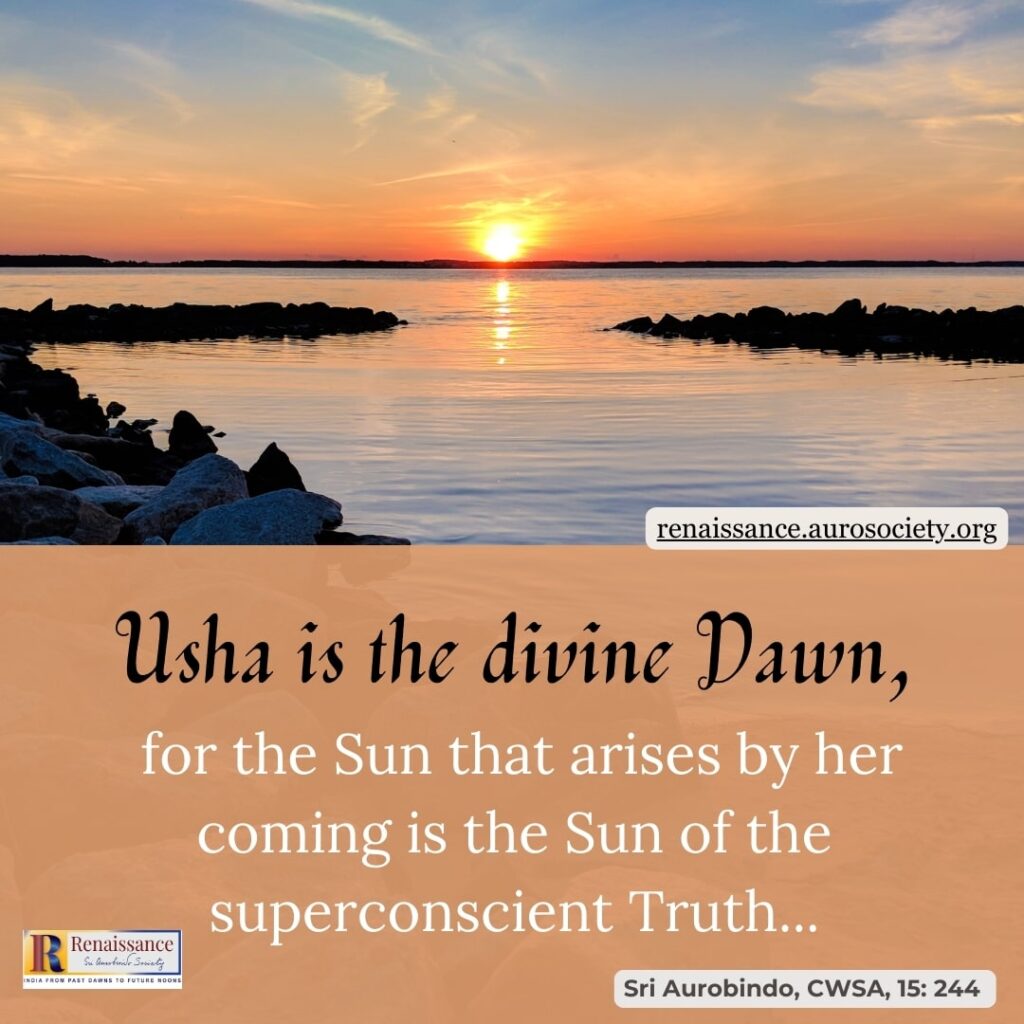
* * *
Around this symbol of the cows and horses much of the Vedic symbolism turns; for these are the chief elements of the riches sought by man from the gods.
The cows of the Dawn have been stolen and concealed by the demons, the lords of darkness in their nether cave of the secret subconscient. They are the illuminations of knowledge, the thoughts of the Truth, gāvo matayaḥ, which have to be delivered out of their imprisonment. Their release is the upsurging of the powers of the divine Dawn.
It is also the recovery of the Sun that was lying in the darkness; for it is said that the Sun, “that Truth”, was the thing found by Indra and the Angirases in the cave of the Panis. By the rending of that cave the herds of the divine dawn which are the rays of the Sun of Truth ascend the hill of being and the Sun itself ascends to the luminous upper ocean of the divine existence, led over it by the thinkers like a ship over the waters, till it reaches its farther shore.
* * *
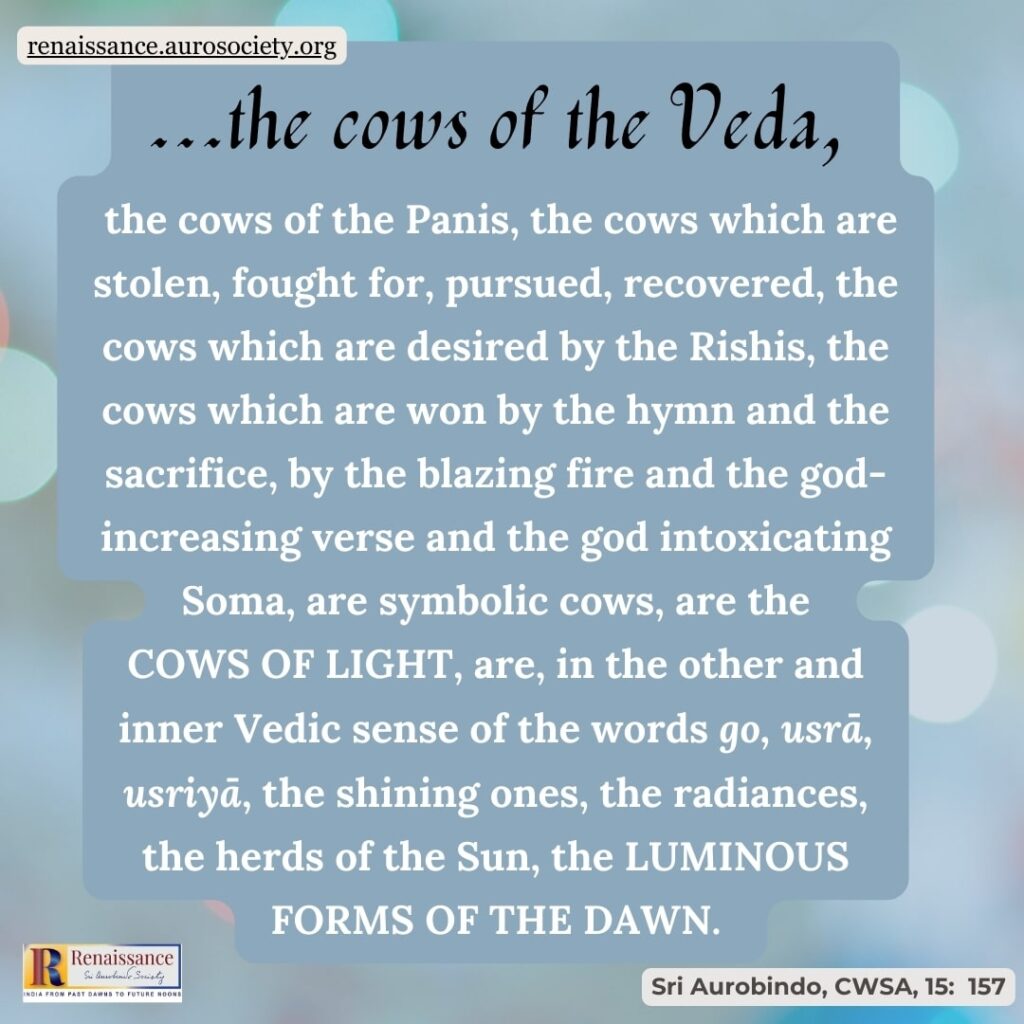
Who concealed the herds of the Sun?
The Panis who conceal the herds, the masters of the nether cavern, are a class of Dasyus who are in the Vedic symbolism set in opposition to the Aryan gods and Aryan seers and workers.
The Aryan is he who does the work of sacrifice, finds the sacred word of illumination, desires the Gods and increases them and is increased by them into the largeness of the true existence; he is the warrior of the light and the traveller to the Truth.
The Dasyu is the undivine being who does no sacrifice, amasses a wealth he cannot rightly use because he cannot speak the word or mentalise the superconscient Truth, hates the Word, the gods and the sacrifice and gives nothing of himself to the higher existences but robs and withholds his wealth from the Aryan. He is the thief, the enemy, the wolf, the devourer, the divider, the obstructor, the confiner.
The Dasyus are powers of darkness and ignorance who oppose the seeker of truth and immortality. The gods are the powers of Light, the children of Infinity, forms and personalities of the one Godhead who by their help and by their growth and human workings in man raise him to the truth and the immortality.
Thus the interpretation of the Angiras myth gives us the key to the whole secret of the Veda.
The cow, horse, ghṛta, and Soma
For if the cows and horses lost by the Aryans and recovered for them by the gods, the cows and horses of which Indra is the lord and giver and indeed himself the Cow and Horse, are not physical cattle, if these elements of the wealth sought by the sacrifice are symbols of a spiritual riches, so also must be its other elements which are always associated with them, sons, men, gold, treasure, etc.
If the Cow of which the ghṛta is the yield is not a physical cow but the shining Mother, then the ghṛta itself which is found in the waters and is said to be triply secreted by the Panis in the Cow, is no physical offering, nor the honey-wine of Soma either which is also said to exist in the rivers and to rise in a honeyed wave from the ocean and to flow streaming up to the gods.
Also Read:
The Legend of the Lost Cows
And if these, then also the other offerings of the sacrifice must be symbolic; the outer sacrifice itself can be nothing but the symbol of an inner giving.
And if the Angiras Rishis are also in part symbolic or are, like the gods, semi-divine workers and helpers in the sacrifice, so also must be the Bhrigus, Atharvans, Ushana and Kutsa and others who are associated with them in their work.
If the Angiras legend and the story of the struggle with the Dasyus is a parable, so also should be the other legendary stories we find in the Rig Veda of the help given by the Gods to the Rishis against the demons; for these also are related in similar terms and constantly classed by the Vedic poets along with the Angiras story as on the same footing.
Similarly if these Dasyus who refuse the gift and the sacrifice, and hate the Word and the gods and with whom the Aryans are constantly at war, these Vritras, Panis and others, are not human enemies but powers of darkness, falsehood and evil, then the whole idea of the Aryan wars and kings and nations begins to take upon itself the aspect of spiritual symbol and apologue.
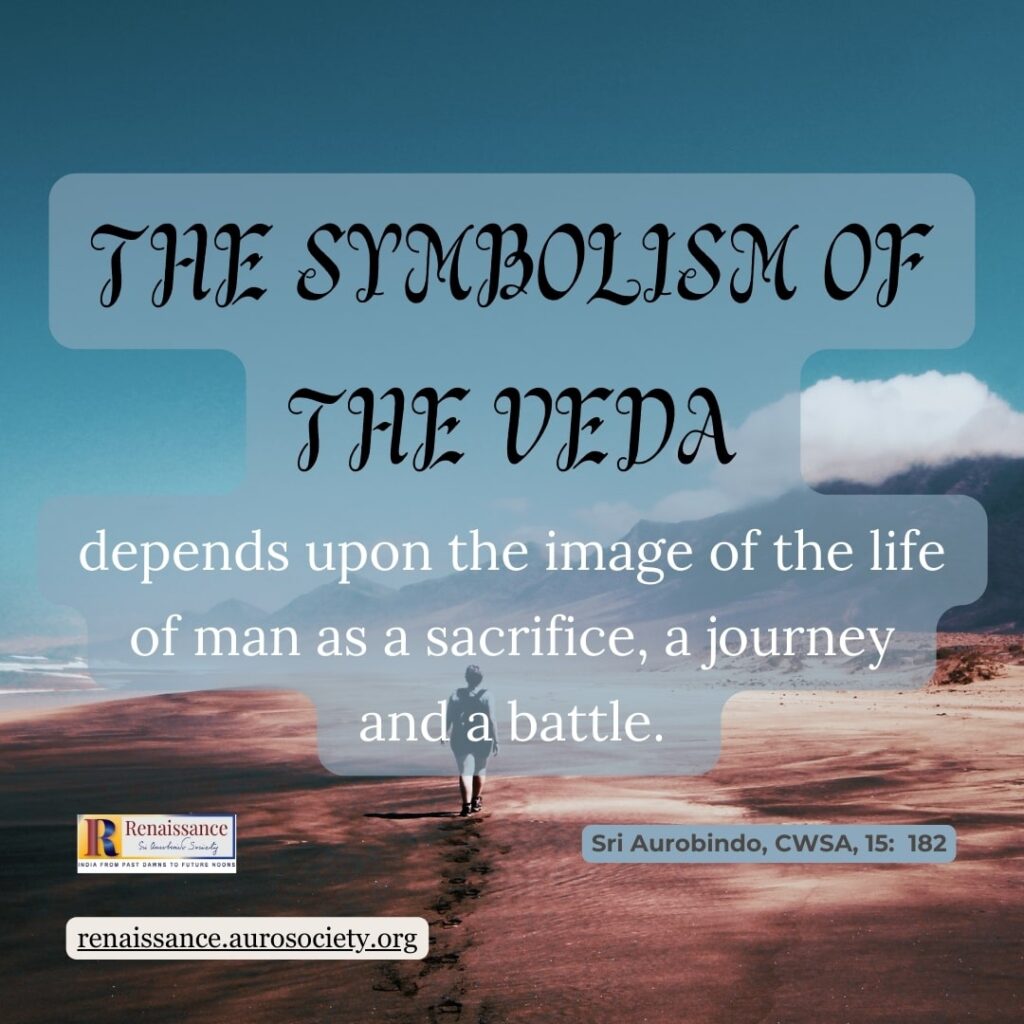
Whether they are entirely so or only partly, cannot be decided except by a more detailed examination which is not our present object. Our object is only to see whether there is a prima facie case for the idea with which we started that the Vedic hymns are the symbolic gospel of the ancient Indian mystics and their sense spiritual and psychological. Such a prima facie case we have established; for there is already sufficient ground for seriously approaching the Veda from this standpoint and interpreting it in detail as such a lyric symbolism.

~ Design: Beloo Mehra



